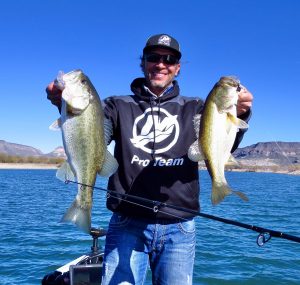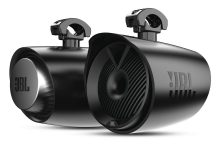AZ Lakes, AZ Pros- Kevin Finley Gets Big Ones At Lake Pleasant
McMillan Stocks pro and Nitro State Team member Kevin Finley runs up to Lake Pleasant frequently – he lives close by, so he has become extremely familiar with this lake. Pleasant has a reputation as a tough lake to fish, but Kevin always manages to pull a few out of the water, and usually some big ones, even in January.

When we went out with Kevin last January, the first bait he threw was a 7- to 8-inch Elaztech floating worm on a 1/8-ounce sinker. The Elaztech worms stand straight up off the bottomThe water temperature was 53 degrees, and he was just barely moving the worm. The fish were from two to thirty-five feet deep, and Kevin said it seemed like the bigger ones were up shallow.
In The Winter
In the winter, says Kevin, you need to cover a lot of water but you still need to use a slow bait. A Texas-rigged worm is perfect for that, and he’ll use it whenever he thinks the fish are hugging the bottom. A drop-shot rig is too high when the fish are active, he says. His electronics play a key role, especially this time of year.
Line is super important. You can have everything perfect and know just where the big fish are, but if your line or your knot is weak, you can lose a big fish. Kevin decided not to believe advertising hype or paid pros – he spent $500 on line and tested it himself. The Sunline Scooter fluorocarbon came out the clear leader for knot strength, he says, and knot strength is the biggest weakness of most fluorocarbon lines.
He does throw braid more than most guys, though, even on a lot of crankbaits. He can throw a deep-diving cranks and feel everything down the bait is doing. He feels like he catches more fish on crankbaits using braid. For spinning gear and finesse applications, he’ll join the fluorocarbon line to braid with an Alberto knot.
He’s Won Doing This
When he’s fishing a Texas rig he only pegs the sinker if he needs to in order to get it through cover. Pegging the sinker, he says, makes you catch fewer fish. When a bass sucks your worm in and it isn’t pegged, the fish has just the worm in his mouth and that makes it easier to set the hook. If you are using a floating worm, put a little slack in the line and the worm floats away from the sinker. He’s won tournaments doing that.
Kevin fishes a lot of floating worms, and he keys on color even more than on the scent he uses. He dips his worms in red or chartreuse dye, which seems to help a lot. In the U.S. Open, he dipped his worm in red dye and on the very next cast he caught a fish and ended up putting twelve pounds in the boat in the next half hour. In muddy water he uses darker colors like black or black and blue.
Flipping Through Spring
One of the techniques that requires pegging the sinker is flipping, and Finley says the biggest mistake you can make is to flip the outside of the cover when the water is low and muddy – those conditions make them go way in the back, so he always flips the middle and uses in vegetation – he says it gets stuck on wood. He’ll use 17-pound-test fluorocarbon for flipping wood, and although it does stretch, most of the stretching is done the first time you set the hook, he says, so after that it’s almost as tight as braid. He started flipping big fish at Bartlett last year in early February, and usually flips his way through the spring.



































